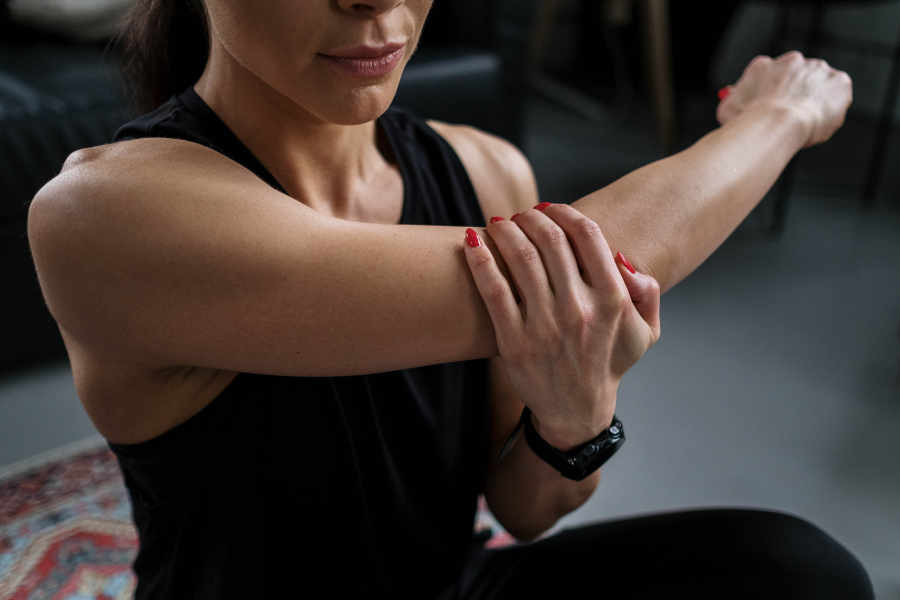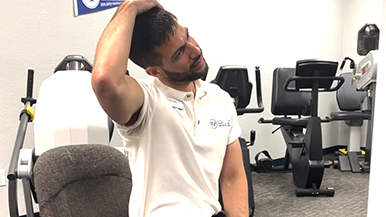Do you suffer from tennis elbow? This condition, also known as lateral epicondylitis, occurs when the forearm muscles connected to the elbow become inflamed. It affects 1 to 3% of the general population.
Repetitive activities like playing racket sports or engaging in certain occupations like painting, carpentry, and plumbing often exacerbate this condition. The symptoms of tennis elbow include pain and a burning sensation on the outer side of the elbow, along with weakened grip strength.

Repetitive activities like playing racket sports or engaging in certain occupations like painting, carpentry, and plumbing often exacerbate this condition. The symptoms of tennis elbow include pain and a burning sensation on the outer side of the elbow, along with weakened grip strength.
These symptoms can develop gradually and may worsen over several weeks or months. The good news is that over 95% of tennis elbow cases can be successfully treated with conservative measures.
If you’re looking for effective exercises to alleviate tennis elbow symptoms and regain strength in your elbow, Ability Rehabilitation can offer you five exercises specifically designed to target tennis elbow.
The Basics of Tennis Elbow Treatment
The optimal treatment for tennis elbow comes after determining the underlying cause, severity, and specific location of symptoms. If you are feeling constant pain and discomfort when swinging or moving your elbow, you should talk to a doctor and get treatment, as well as occupational therapy.
There are several common treatment modalities that your doctor may recommend:
- Pain relief: Medical practitioners often prescribe anti-inflammatories like Ibuprofen or Nurofen to alleviate the discomfort associated with tennis elbow. Every condition is different and other pain management may also be recommended depending on severity.
- Ice therapy: Applying ice to the affected area can temporarily relieve pain and inflammation and facilitate participation in other therapeutic interventions, such as physiotherapy.
- Rest: While rest can provide short-term pain relief, complete immobilization may not be necessary. Instead, a ‘relative rest’ strategy is often employed, which involves reducing the load on the affected arm while gradually reintroducing gentle movements.
- Corticosteroid injections: In some instances, a healthcare provider may recommend corticosteroid injections administered near the site of pain to alleviate symptoms and disrupt the pain cycle. This approach can enhance tolerance to other treatments, such as exercise, in the short term.
- Occupational and Physical Therapy: Occupational therapy is pivotal in the recovery process, particularly in tendon rehabilitation. Your occupational or physical therapist may prescribe tailored exercises aimed at reconditioning the muscles and enhancing the load-bearing capacity of the affected tendon.
5 Exercises For Tennis Elbow
1. Fist clench
Reduced grip strength often accompanies tennis elbow, hindering everyday activities. Strengthening your forearm muscles can enhance your grip strength and overall functionality.
Equipment needed: Table and towel
Muscles targeted: Long flexor tendons of the fingers and thumb
Instructions:
- Sit at a table with your forearm comfortably resting on its surface.
- Grasp a rolled-up towel or small ball firmly in your hand.
- Squeeze the towel or ball tightly for 10 seconds.
- Release the grip and relax.
- Repeat this exercise 10 times. Do the same routine with the opposite arm for a balanced workout.

2. Supination with a Dumbbell
The supinator muscle, a significant forearm muscle, connects to your elbow and plays a key role in rotating your palm upward. This muscle often contributes to movements that can lead to tennis elbow.
Before engaging in the supination exercises below, it’s advisable to practice isometric supination without weights: Maintain your elbow’s position while turning your palm upward and holding for approximately 30 seconds.
Equipment needed: Table and 1-pound dumbbell
Muscles targeted: Supinator muscle
Instructions:
- Sit comfortably in a chair, holding a 1-pound dumbbell vertically in one hand, with your elbow resting on your knee.
- Allow the weight of the dumbbell to assist in outwardly rotating your arm, turning your palm upward.
- Rotate your hand in the opposite direction until your palm faces downward.
- Do 20 repetitions on each side.
- Focus on isolating the movement to your lower arm while keeping your upper arm and elbow stationary.

3. Wrist Extension
The wrist extensors are a group of muscles responsible for bending your wrist, akin to the motion of making a “stop” hand signal. These muscles, which connect to your elbow, are often prone to overuse, particularly in activities like racket sports.
Equipment needed: Table and 2-pound dumbbell
Muscles targeted: Wrist extensors
Instructions:
- Sit comfortably in a chair, holding a 2-pound dumbbell in one hand, with your palm facing downward. Rest your elbow comfortably on your knee.
- Maintain the palm-down position and extend your wrist by curling it toward your body. If this movement is too challenging, try it without weights.
- Return to the starting position and repeat the exercise 10 times on each side.
- Focus on isolating the movement to your wrist, keeping the remainder of your arm stationary.

4. Wrist Flexion
The wrist flexors are a group of muscles that oppose the wrist extensors. These small muscles, which attach to the elbow, are also prone to overuse, leading to pain and inflammation.
Equipment needed: Table and 2-pound dumbbell
Muscles targeted: Wrist flexors
Instructions:
- Sit in a chair with proper posture, holding a 2-pound dumbbell in one hand, palm facing upward. Rest your elbow comfortably on your knee.
- Maintain the palm-up position and flex your wrist by curling it toward your body.
- Return to the starting position and repeat the movement 10 times on each side.
- Focus on isolating the movement to your wrist while keeping the rest of your arm still.

5. Towel Twist
Equipment needed: Hand towel
Muscles engaged: Wrist extensors, wrist flexors
Instructions:
- Sit comfortably in a chair with your shoulders relaxed.
- Hold a hand towel with both hands.
- Twist the towel in opposite directions with both hands as if wringing out water.
- Repeat the twisting motion 10 times, then switch directions and repeat another 10 times.

Should You Exercise with Tennis Elbow?
Before starting any exercise program, consulting with a healthcare professional is essential. A comprehensive evaluation is necessary to rule out potential serious injuries, such as muscle or tendon tears.
It’s important to avoid engaging in activities until inflammation has diminished, as further activity could worsen the condition. If pain resurfaces after physical exertion, it’s advisable to rest and apply ice to the affected elbow and forearm. Seeking guidance from a physical or occupational therapist ensures proper exercise execution.
Sometimes, modifying the way you do daily activities can alleviate symptoms. Your therapist can help you identify movements that may contribute to pain and suggest alternative approaches.
Occupational and Physical Therapy For Tennis Elbow
In addition to these exercises, occupational and physical therapy can be valuable components of recovery from tennis elbow. A skilled occupational therapist can provide personalized guidance, hands-on techniques, and targeted interventions to address your specific needs and accelerate your recovery.
Next Steps for Tennis Elbow Recovery
Are you struggling with tennis elbow and looking for ways to recover? At Ability Rehabilitation, our team of skilled therapists is dedicated to assisting you in every possible way. We understand you need personalized care to address your unique concerns and requirements. Our team will work with you to develop a customized treatment plan to alleviate your pain and prevent future injuries. Don’t let tennis elbow hinder your progress any longer. Schedule an appointment today for a brighter and healthier tomorrow.



